Alpha mapping in OpenGL 4.0 is the process of using the alpha layer of a texture to determine the blending amount for each pixel when combining two textures.
To start the process, you first create an alpha layer for a texture such as follows:

Each pixel is just a 0.0 to 1.0 float range indicating how to combine two textures.
For example, if the alpha value at a certain pixel is 0.3 you would take 30% of the base texture pixel value and combine it with 70% of the color texture pixel.
In this tutorial we will combine the following two textures based on the alpha map:
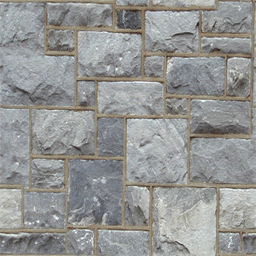
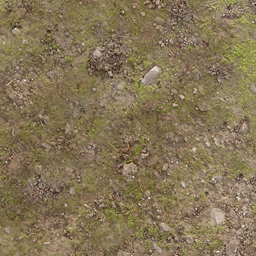
The final result will be the following:
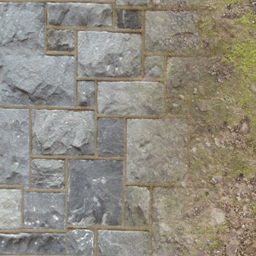
In this tutorial I will be separating the alpha map onto its own individual texture.
This gives us the ability to create several alpha maps and then combine the same two color and base textures in many different ways.
The code in this tutorial is based on the previous tutorial.
Framework
The framework has been updated to replace LightMapShaderClass with the new AlphaMapShaderClass.
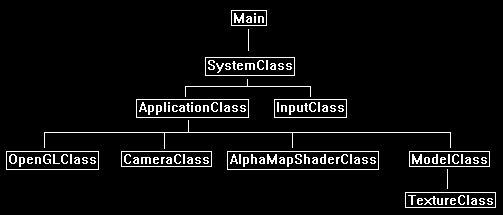
Alphamap.vs
The alpha map vertex shader is just the light map shader renamed from the previous tutorial.
////////////////////////////////////////////////////////////////////////////////
// Filename: alphamap.vs
////////////////////////////////////////////////////////////////////////////////
#version 400
/////////////////////
// INPUT VARIABLES //
/////////////////////
in vec3 inputPosition;
in vec2 inputTexCoord;
in vec3 inputNormal;
//////////////////////
// OUTPUT VARIABLES //
//////////////////////
out vec2 texCoord;
///////////////////////
// UNIFORM VARIABLES //
///////////////////////
uniform mat4 worldMatrix;
uniform mat4 viewMatrix;
uniform mat4 projectionMatrix;
////////////////////////////////////////////////////////////////////////////////
// Vertex Shader
////////////////////////////////////////////////////////////////////////////////
void main(void)
{
// Calculate the position of the vertex against the world, view, and projection matrices.
gl_Position = vec4(inputPosition, 1.0f) * worldMatrix;
gl_Position = gl_Position * viewMatrix;
gl_Position = gl_Position * projectionMatrix;
// Store the texture coordinates for the pixel shader.
texCoord = inputTexCoord;
}
Alphamap.ps
////////////////////////////////////////////////////////////////////////////////
// Filename: alphamap.ps
////////////////////////////////////////////////////////////////////////////////
#version 400
/////////////////////
// INPUT VARIABLES //
/////////////////////
in vec2 texCoord;
//////////////////////
// OUTPUT VARIABLES //
//////////////////////
out vec4 outputColor;
The first change to the pixel shader is the addition of a third texture sampler.
///////////////////////
// UNIFORM VARIABLES //
///////////////////////
uniform sampler2D shaderTexture1;
uniform sampler2D shaderTexture2;
uniform sampler2D shaderTexture3;
In the alpha map pixel shader, we first take a sample of the pixel from the two color textures and alpha texture.
Then we multiply the alpha value by the base color to get the pixel value for the base texture.
After that we multiply the inverse of the alpha (1.0 - alpha) by the second color texture to get the pixel value for the second texture.
We then add the two pixel values together and saturate to produce the final blended pixel.
////////////////////////////////////////////////////////////////////////////////
// Pixel Shader
////////////////////////////////////////////////////////////////////////////////
void main(void)
{
vec4 color1;
vec4 color2;
vec4 alphaValue;
vec4 blendColor;
// Get the pixel color from the first texture.
color1 = texture(shaderTexture1, texCoord);
// Get the pixel color from the second texture.
color2 = texture(shaderTexture2, texCoord);
// Get the pixel color from the alpha texture.
alphaValue = texture(shaderTexture3, texCoord);
// Combine the two textures based on the alpha value.
blendColor = (alphaValue * color1) + ((1.0 - alphaValue) * color2);
// Saturate the final color value.
outputColor = clamp(blendColor, 0.0f, 1.0f);
}
Alphamapshaderclass.h
The AlphaMapShaderClass is the LightMapShaderClass slightly modified from the previous tutorial.
////////////////////////////////////////////////////////////////////////////////
// Filename: alphamapshaderclass.h
////////////////////////////////////////////////////////////////////////////////
#ifndef _ALPHAMAPSHADERCLASS_H_
#define _ALPHAMAPSHADERCLASS_H_
//////////////
// INCLUDES //
//////////////
#include <iostream>
using namespace std;
///////////////////////
// MY CLASS INCLUDES //
///////////////////////
#include "openglclass.h"
////////////////////////////////////////////////////////////////////////////////
// Class name: AlphaMapShaderClass
////////////////////////////////////////////////////////////////////////////////
class AlphaMapShaderClass
{
public:
AlphaMapShaderClass();
AlphaMapShaderClass(const AlphaMapShaderClass&);
~AlphaMapShaderClass();
bool Initialize(OpenGLClass*);
void Shutdown();
bool SetShaderParameters(float*, float*, float*);
private:
bool InitializeShader(char*, char*);
void ShutdownShader();
char* LoadShaderSourceFile(char*);
void OutputShaderErrorMessage(unsigned int, char*);
void OutputLinkerErrorMessage(unsigned int);
private:
OpenGLClass* m_OpenGLPtr;
unsigned int m_vertexShader;
unsigned int m_fragmentShader;
unsigned int m_shaderProgram;
};
#endif
Alphamapshaderclass.cpp
////////////////////////////////////////////////////////////////////////////////
// Filename: alphamapshaderclass.cpp
////////////////////////////////////////////////////////////////////////////////
#include "alphamapshaderclass.h"
AlphaMapShaderClass::AlphaMapShaderClass()
{
m_OpenGLPtr = 0;
}
AlphaMapShaderClass::AlphaMapShaderClass(const AlphaMapShaderClass& other)
{
}
AlphaMapShaderClass::~AlphaMapShaderClass()
{
}
bool AlphaMapShaderClass::Initialize(OpenGLClass* OpenGL)
{
char vsFilename[128];
char psFilename[128];
bool result;
// Store the pointer to the OpenGL object.
m_OpenGLPtr = OpenGL;
The first change in the AlphaMapShaderClass from the LightMapShaderClass is that we now use alphamap.vs and alphamap.ps.
// Set the location and names of the shader files.
strcpy(vsFilename, "../Engine/alphamap.vs");
strcpy(psFilename, "../Engine/alphamap.ps");
// Initialize the vertex and pixel shaders.
result = InitializeShader(vsFilename, psFilename);
if(!result)
{
return false;
}
return true;
}
void AlphaMapShaderClass::Shutdown()
{
// Shutdown the shader.
ShutdownShader();
// Release the pointer to the OpenGL object.
m_OpenGLPtr = 0;
return;
}
bool AlphaMapShaderClass::InitializeShader(char* vsFilename, char* fsFilename)
{
const char* vertexShaderBuffer;
const char* fragmentShaderBuffer;
int status;
// Load the vertex shader source file into a text buffer.
vertexShaderBuffer = LoadShaderSourceFile(vsFilename);
if(!vertexShaderBuffer)
{
return false;
}
// Load the fragment shader source file into a text buffer.
fragmentShaderBuffer = LoadShaderSourceFile(fsFilename);
if(!fragmentShaderBuffer)
{
return false;
}
// Create a vertex and fragment shader object.
m_vertexShader = m_OpenGLPtr->glCreateShader(GL_VERTEX_SHADER);
m_fragmentShader = m_OpenGLPtr->glCreateShader(GL_FRAGMENT_SHADER);
// Copy the shader source code strings into the vertex and fragment shader objects.
m_OpenGLPtr->glShaderSource(m_vertexShader, 1, &vertexShaderBuffer, NULL);
m_OpenGLPtr->glShaderSource(m_fragmentShader, 1, &fragmentShaderBuffer, NULL);
// Release the vertex and fragment shader buffers.
delete [] vertexShaderBuffer;
vertexShaderBuffer = 0;
delete [] fragmentShaderBuffer;
fragmentShaderBuffer = 0;
// Compile the shaders.
m_OpenGLPtr->glCompileShader(m_vertexShader);
m_OpenGLPtr->glCompileShader(m_fragmentShader);
// Check to see if the vertex shader compiled successfully.
m_OpenGLPtr->glGetShaderiv(m_vertexShader, GL_COMPILE_STATUS, &status);
if(status != 1)
{
// If it did not compile then write the syntax error message out to a text file for review.
OutputShaderErrorMessage(m_vertexShader, vsFilename);
return false;
}
// Check to see if the fragment shader compiled successfully.
m_OpenGLPtr->glGetShaderiv(m_fragmentShader, GL_COMPILE_STATUS, &status);
if(status != 1)
{
// If it did not compile then write the syntax error message out to a text file for review.
OutputShaderErrorMessage(m_fragmentShader, fsFilename);
return false;
}
// Create a shader program object.
m_shaderProgram = m_OpenGLPtr->glCreateProgram();
// Attach the vertex and fragment shader to the program object.
m_OpenGLPtr->glAttachShader(m_shaderProgram, m_vertexShader);
m_OpenGLPtr->glAttachShader(m_shaderProgram, m_fragmentShader);
// Bind the shader input variables.
m_OpenGLPtr->glBindAttribLocation(m_shaderProgram, 0, "inputPosition");
m_OpenGLPtr->glBindAttribLocation(m_shaderProgram, 1, "inputTexCoord");
m_OpenGLPtr->glBindAttribLocation(m_shaderProgram, 2, "inputNormal");
// Link the shader program.
m_OpenGLPtr->glLinkProgram(m_shaderProgram);
// Check the status of the link.
m_OpenGLPtr->glGetProgramiv(m_shaderProgram, GL_LINK_STATUS, &status);
if(status != 1)
{
// If it did not link then write the syntax error message out to a text file for review.
OutputLinkerErrorMessage(m_shaderProgram);
return false;
}
return true;
}
void AlphaMapShaderClass::ShutdownShader()
{
// Detach the vertex and fragment shaders from the program.
m_OpenGLPtr->glDetachShader(m_shaderProgram, m_vertexShader);
m_OpenGLPtr->glDetachShader(m_shaderProgram, m_fragmentShader);
// Delete the vertex and fragment shaders.
m_OpenGLPtr->glDeleteShader(m_vertexShader);
m_OpenGLPtr->glDeleteShader(m_fragmentShader);
// Delete the shader program.
m_OpenGLPtr->glDeleteProgram(m_shaderProgram);
return;
}
char* AlphaMapShaderClass::LoadShaderSourceFile(char* filename)
{
FILE* filePtr;
char* buffer;
long fileSize, count;
int error;
// Open the shader file for reading in text modee.
filePtr = fopen(filename, "r");
if(filePtr == NULL)
{
return 0;
}
// Go to the end of the file and get the size of the file.
fseek(filePtr, 0, SEEK_END);
fileSize = ftell(filePtr);
// Initialize the buffer to read the shader source file into, adding 1 for an extra null terminator.
buffer = new char[fileSize + 1];
// Return the file pointer back to the beginning of the file.
fseek(filePtr, 0, SEEK_SET);
// Read the shader text file into the buffer.
count = fread(buffer, 1, fileSize, filePtr);
if(count != fileSize)
{
return 0;
}
// Close the file.
error = fclose(filePtr);
if(error != 0)
{
return 0;
}
// Null terminate the buffer.
buffer[fileSize] = '\0';
return buffer;
}
void AlphaMapShaderClass::OutputShaderErrorMessage(unsigned int shaderId, char* shaderFilename)
{
long count;
int logSize, error;
char* infoLog;
FILE* filePtr;
// Get the size of the string containing the information log for the failed shader compilation message.
m_OpenGLPtr->glGetShaderiv(shaderId, GL_INFO_LOG_LENGTH, &logSize);
// Increment the size by one to handle also the null terminator.
logSize++;
// Create a char buffer to hold the info log.
infoLog = new char[logSize];
// Now retrieve the info log.
m_OpenGLPtr->glGetShaderInfoLog(shaderId, logSize, NULL, infoLog);
// Open a text file to write the error message to.
filePtr = fopen("shader-error.txt", "w");
if(filePtr == NULL)
{
cout << "Error opening shader error message output file." << endl;
return;
}
// Write out the error message.
count = fwrite(infoLog, sizeof(char), logSize, filePtr);
if(count != logSize)
{
cout << "Error writing shader error message output file." << endl;
return;
}
// Close the file.
error = fclose(filePtr);
if(error != 0)
{
cout << "Error closing shader error message output file." << endl;
return;
}
// Notify the user to check the text file for compile errors.
cout << "Error compiling shader. Check shader-error.txt for error message. Shader filename: " << shaderFilename << endl;
return;
}
void AlphaMapShaderClass::OutputLinkerErrorMessage(unsigned int programId)
{
long count;
FILE* filePtr;
int logSize, error;
char* infoLog;
// Get the size of the string containing the information log for the failed shader compilation message.
m_OpenGLPtr->glGetProgramiv(programId, GL_INFO_LOG_LENGTH, &logSize);
// Increment the size by one to handle also the null terminator.
logSize++;
// Create a char buffer to hold the info log.
infoLog = new char[logSize];
// Now retrieve the info log.
m_OpenGLPtr->glGetProgramInfoLog(programId, logSize, NULL, infoLog);
// Open a file to write the error message to.
filePtr = fopen("linker-error.txt", "w");
if(filePtr == NULL)
{
cout << "Error opening linker error message output file." << endl;
return;
}
// Write out the error message.
count = fwrite(infoLog, sizeof(char), logSize, filePtr);
if(count != logSize)
{
cout << "Error writing linker error message output file." << endl;
return;
}
// Close the file.
error = fclose(filePtr);
if(error != 0)
{
cout << "Error closing linker error message output file." << endl;
return;
}
// Pop a message up on the screen to notify the user to check the text file for linker errors.
cout << "Error linking shader program. Check linker-error.txt for message." << endl;
return;
}
bool AlphaMapShaderClass::SetShaderParameters(float* worldMatrix, float* viewMatrix, float* projectionMatrix)
{
float tpWorldMatrix[16], tpViewMatrix[16], tpProjectionMatrix[16];
int location;
// Transpose the matrices to prepare them for the shader.
m_OpenGLPtr->MatrixTranspose(tpWorldMatrix, worldMatrix);
m_OpenGLPtr->MatrixTranspose(tpViewMatrix, viewMatrix);
m_OpenGLPtr->MatrixTranspose(tpProjectionMatrix, projectionMatrix);
// Install the shader program as part of the current rendering state.
m_OpenGLPtr->glUseProgram(m_shaderProgram);
// Set the world matrix in the vertex shader.
location = m_OpenGLPtr->glGetUniformLocation(m_shaderProgram, "worldMatrix");
if(location == -1)
{
cout << "World matrix not set." << endl;
}
m_OpenGLPtr ->glUniformMatrix4fv(location, 1, false, tpWorldMatrix);
// Set the view matrix in the vertex shader.
location = m_OpenGLPtr->glGetUniformLocation(m_shaderProgram, "viewMatrix");
if(location == -1)
{
cout << "View matrix not set." << endl;
}
m_OpenGLPtr->glUniformMatrix4fv(location, 1, false, tpViewMatrix);
// Set the projection matrix in the vertex shader.
location = m_OpenGLPtr->glGetUniformLocation(m_shaderProgram, "projectionMatrix");
if(location == -1)
{
cout << "Projection matrix not set." << endl;
}
m_OpenGLPtr->glUniformMatrix4fv(location, 1, false, tpProjectionMatrix);
// Set the first texture in the pixel shader to use the data from the first texture unit.
location = m_OpenGLPtr->glGetUniformLocation(m_shaderProgram, "shaderTexture1");
if(location == -1)
{
cout << "Shader texture 1 not set." << endl;
}
m_OpenGLPtr->glUniform1i(location, 0);
// Set the second texture in the pixel shader to use the data from the second texture unit.
location = m_OpenGLPtr->glGetUniformLocation(m_shaderProgram, "shaderTexture2");
if(location == -1)
{
cout << "Shader texture 2 not set." << endl;
}
m_OpenGLPtr->glUniform1i(location, 1);
In the SetShaderParameters function we now setup a third texture sampler.
This will be the alpha texture since the first two texture samplers were the two color textures.
// Set the third texture in the pixel shader to use the data from the third texture unit.
location = m_OpenGLPtr->glGetUniformLocation(m_shaderProgram, "shaderTexture3");
if(location == -1)
{
cout << "Shader texture 3 not set." << endl;
}
m_OpenGLPtr->glUniform1i(location, 2);
return true;
}
Modelclass.h
The ModelClass has been modified to use a third texture now.
It has also been modified so that you can send in a NULL as a filename and use less textures.
////////////////////////////////////////////////////////////////////////////////
// Filename: modelclass.h
////////////////////////////////////////////////////////////////////////////////
#ifndef _MODELCLASS_H_
#define _MODELCLASS_H_
//////////////
// INCLUDES //
//////////////
#include <fstream>
using namespace std;
///////////////////////
// MY CLASS INCLUDES //
///////////////////////
#include "textureclass.h"
////////////////////////////////////////////////////////////////////////////////
// Class Name: ModelClass
////////////////////////////////////////////////////////////////////////////////
class ModelClass
{
private:
struct VertexType
{
float x, y, z;
float tu, tv;
float nx, ny, nz;
};
struct ModelType
{
float x, y, z;
float tu, tv;
float nx, ny, nz;
};
public:
ModelClass();
ModelClass(const ModelClass&);
~ModelClass();
bool Initialize(OpenGLClass*, char*, char*, bool, char*, bool, char*, bool);
void Shutdown();
void Render();
void SetTexture1(unsigned int);
void SetTexture2(unsigned int);
void SetTexture3(unsigned int);
private:
bool InitializeBuffers();
void ShutdownBuffers();
void RenderBuffers();
bool LoadTextures(char*, bool, char*, bool, char*, bool);
void ReleaseTextures();
bool LoadModel(char*);
void ReleaseModel();
private:
OpenGLClass* m_OpenGLPtr;
int m_vertexCount, m_indexCount;
unsigned int m_vertexArrayId, m_vertexBufferId, m_indexBufferId;
TextureClass* m_Textures;
bool m_texture1Loaded, m_texture2Loaded, m_texture3Loaded;
ModelType* m_model;
};
#endif
Modelclass.cpp
////////////////////////////////////////////////////////////////////////////////
// Filename: modelclass.cpp
////////////////////////////////////////////////////////////////////////////////
#include "modelclass.h"
ModelClass::ModelClass()
{
m_OpenGLPtr = 0;
m_Textures = 0;
m_texture1Loaded = false;
m_texture2Loaded = false;
m_texture3Loaded = false;
m_model = 0;
}
ModelClass::ModelClass(const ModelClass& other)
{
}
ModelClass::~ModelClass()
{
}
bool ModelClass::Initialize(OpenGLClass* OpenGL, char* modelFilename, char* textureFilename1, bool wrap1, char* textureFilename2, bool wrap2,
char* textureFilename3, bool wrap3)
{
bool result;
// Store a pointer to the OpenGL object.
m_OpenGLPtr = OpenGL;
// Load in the model data.
result = LoadModel(modelFilename);
if(!result)
{
return false;
}
// Initialize the vertex and index buffer that hold the geometry for the triangle.
result = InitializeBuffers();
if(!result)
{
return false;
}
// Load the textures for this model.
result = LoadTextures(textureFilename1, wrap1, textureFilename2, wrap2, textureFilename3, wrap3);
if(!result)
{
return false;
}
return true;
}
void ModelClass::Shutdown()
{
// Release the textures used for this model.
ReleaseTextures();
// Release the vertex and index buffers.
ShutdownBuffers();
// Release the model data.
ReleaseModel();
// Release the pointer to the OpenGL object.
m_OpenGLPtr = 0;
return;
}
void ModelClass::Render()
{
// Put the vertex and index buffers on the graphics pipeline to prepare them for drawing.
RenderBuffers();
return;
}
bool ModelClass::InitializeBuffers()
{
VertexType* vertices;
unsigned int* indices;
int i;
// Create the vertex array.
vertices = new VertexType[m_vertexCount];
// Create the index array.
indices = new unsigned int[m_indexCount];
// Load the vertex array and index array with data.
for(i=0; i<m_vertexCount; i++)
{
vertices[i].x = m_model[i].x;
vertices[i].y = m_model[i].y;
vertices[i].z = m_model[i].z;
vertices[i].tu = m_model[i].tu;
vertices[i].tv = m_model[i].tv;
vertices[i].nx = m_model[i].nx;
vertices[i].ny = m_model[i].ny;
vertices[i].nz = m_model[i].nz;
indices[i] = i;
}
// Allocate an OpenGL vertex array object.
m_OpenGLPtr->glGenVertexArrays(1, &m_vertexArrayId);
// Bind the vertex array object to store all the buffers and vertex attributes we create here.
m_OpenGLPtr->glBindVertexArray(m_vertexArrayId);
// Generate an ID for the vertex buffer.
m_OpenGLPtr->glGenBuffers(1, &m_vertexBufferId);
// Bind the vertex buffer and load the vertex (position and color) data into the vertex buffer.
m_OpenGLPtr->glBindBuffer(GL_ARRAY_BUFFER, m_vertexBufferId);
m_OpenGLPtr->glBufferData(GL_ARRAY_BUFFER, m_vertexCount * sizeof(VertexType), vertices, GL_STATIC_DRAW);
// Enable the two vertex array attributes.
m_OpenGLPtr->glEnableVertexAttribArray(0); // Vertex position.
m_OpenGLPtr->glEnableVertexAttribArray(1); // Texture coordinates.
m_OpenGLPtr->glEnableVertexAttribArray(2); // Normals
// Specify the location and format of the position portion of the vertex buffer.
m_OpenGLPtr->glVertexAttribPointer(0, 3, GL_FLOAT, false, sizeof(VertexType), 0);
// Specify the location and format of the texture coordinates portion of the vertex buffer.
m_OpenGLPtr->glVertexAttribPointer(1, 2, GL_FLOAT, false, sizeof(VertexType), (unsigned char*)NULL + (3 * sizeof(float)));
// Specify the location and format of the normal vector portion of the vertex buffer.
m_OpenGLPtr->glVertexAttribPointer(2, 3, GL_FLOAT, false, sizeof(VertexType), (unsigned char*)NULL + (5 * sizeof(float)));
// Generate an ID for the index buffer.
m_OpenGLPtr->glGenBuffers(1, &m_indexBufferId);
// Bind the index buffer and load the index data into it.
m_OpenGLPtr->glBindBuffer(GL_ELEMENT_ARRAY_BUFFER, m_indexBufferId);
m_OpenGLPtr->glBufferData(GL_ELEMENT_ARRAY_BUFFER, m_indexCount* sizeof(unsigned int), indices, GL_STATIC_DRAW);
// Now that the buffers have been loaded we can release the array data.
delete [] vertices;
vertices = 0;
delete [] indices;
indices = 0;
return true;
}
void ModelClass::ShutdownBuffers()
{
// Release the vertex array object.
m_OpenGLPtr->glBindVertexArray(0);
m_OpenGLPtr->glDeleteVertexArrays(1, &m_vertexArrayId);
// Release the vertex buffer.
m_OpenGLPtr->glBindBuffer(GL_ARRAY_BUFFER, 0);
m_OpenGLPtr->glDeleteBuffers(1, &m_vertexBufferId);
// Release the index buffer.
m_OpenGLPtr->glBindBuffer(GL_ELEMENT_ARRAY_BUFFER, 0);
m_OpenGLPtr->glDeleteBuffers(1, &m_indexBufferId);
return;
}
void ModelClass::RenderBuffers()
{
// Bind the vertex array object that stored all the information about the vertex and index buffers.
m_OpenGLPtr->glBindVertexArray(m_vertexArrayId);
// Render the vertex buffer using the index buffer.
glDrawElements(GL_TRIANGLES, m_indexCount, GL_UNSIGNED_INT, 0);
return;
}
bool ModelClass::LoadTextures(char* textureFilename1, bool wrap1, char* textureFilename2, bool wrap2, char* textureFilename3, bool wrap3)
{
// Create and initialize the texture objects.
m_Textures = new TextureClass[3];
if(textureFilename1 != NULL)
{
m_texture1Loaded = m_Textures[0].Initialize(m_OpenGLPtr, textureFilename1, wrap1);
if(!m_texture1Loaded)
{
return false;
}
}
if(textureFilename2 != NULL)
{
m_texture2Loaded = m_Textures[1].Initialize(m_OpenGLPtr, textureFilename2, wrap2);
if(!m_texture2Loaded)
{
return false;
}
}
if(textureFilename3 != NULL)
{
m_texture3Loaded = m_Textures[2].Initialize(m_OpenGLPtr, textureFilename3, wrap3);
if(!m_texture3Loaded)
{
return false;
}
}
return true;
}
void ModelClass::ReleaseTextures()
{
// Release the texture objects.
if(m_Textures)
{
m_Textures[0].Shutdown();
m_Textures[1].Shutdown();
m_Textures[2].Shutdown();
delete [] m_Textures;
m_Textures = 0;
}
return;
}
void ModelClass::SetTexture1(unsigned int textureUnit)
{
// Set the first texture for the model.
if(m_texture1Loaded)
{
m_Textures[0].SetTexture(m_OpenGLPtr, textureUnit);
}
return;
}
void ModelClass::SetTexture2(unsigned int textureUnit)
{
// Set the second texture for the model.
if(m_texture2Loaded)
{
m_Textures[1].SetTexture(m_OpenGLPtr, textureUnit);
}
return;
}
void ModelClass::SetTexture3(unsigned int textureUnit)
{
// Set the third texture for the model.
if(m_texture3Loaded)
{
m_Textures[2].SetTexture(m_OpenGLPtr, textureUnit);
}
return;
}
bool ModelClass::LoadModel(char* filename)
{
ifstream fin;
char input;
int i;
// Open the model file.
fin.open(filename);
// If it could not open the file then exit.
if(fin.fail())
{
return false;
}
// Read up to the value of vertex count.
fin.get(input);
while(input != ':')
{
fin.get(input);
}
// Read in the vertex count.
fin >> m_vertexCount;
// Set the number of indices to be the same as the vertex count.
m_indexCount = m_vertexCount;
// Create the model using the vertex count that was read in.
m_model = new ModelType[m_vertexCount];
// Read up to the beginning of the data.
fin.get(input);
while(input != ':')
{
fin.get(input);
}
fin.get(input);
fin.get(input);
// Read in the vertex data.
for(i=0; i<m_vertexCount; i++)
{
fin >> m_model[i].x >> m_model[i].y >> m_model[i].z;
fin >> m_model[i].tu >> m_model[i].tv;
fin >> m_model[i].nx >> m_model[i].ny >> m_model[i].nz;
// Invert the V coordinate to match the OpenGL texture coordinate system.
m_model[i].tv = 1.0f - m_model[i].tv;
}
// Close the model file.
fin.close();
return true;
}
void ModelClass::ReleaseModel()
{
if(m_model)
{
delete [] m_model;
m_model = 0;
}
return;
}
Applicationclass.h
We have added the new AlphaMapShaderClass to the ApplicationClass.
////////////////////////////////////////////////////////////////////////////////
// Filename: applicationclass.h
////////////////////////////////////////////////////////////////////////////////
#ifndef _APPLICATIONCLASS_H_
#define _APPLICATIONCLASS_H_
/////////////
// GLOBALS //
/////////////
const bool FULL_SCREEN = false;
const bool VSYNC_ENABLED = true;
const float SCREEN_NEAR = 0.3f;
const float SCREEN_DEPTH = 1000.0f;
///////////////////////
// MY CLASS INCLUDES //
///////////////////////
#include "inputclass.h"
#include "openglclass.h"
#include "cameraclass.h"
#include "alphamapshaderclass.h"
#include "modelclass.h"
////////////////////////////////////////////////////////////////////////////////
// Class Name: ApplicationClass
////////////////////////////////////////////////////////////////////////////////
class ApplicationClass
{
public:
ApplicationClass();
ApplicationClass(const ApplicationClass&);
~ApplicationClass();
bool Initialize(Display*, Window, int, int);
void Shutdown();
bool Frame(InputClass*);
private:
bool Render();
private:
OpenGLClass* m_OpenGL;
CameraClass* m_Camera;
AlphaMapShaderClass* m_AlphaMapShader;
ModelClass* m_Model;
};
#endif
Applicationclass.cpp
////////////////////////////////////////////////////////////////////////////////
// Filename: applicationclass.cpp
////////////////////////////////////////////////////////////////////////////////
#include "applicationclass.h"
ApplicationClass::ApplicationClass()
{
m_OpenGL = 0;
m_Camera = 0;
m_AlphaMapShader = 0;
m_Model = 0;
}
ApplicationClass::ApplicationClass(const ApplicationClass& other)
{
}
ApplicationClass::~ApplicationClass()
{
}
bool ApplicationClass::Initialize(Display* display, Window win, int screenWidth, int screenHeight)
{
char modelFilename[128], textureFilename1[128], textureFilename2[128], textureFilename3[128];
bool result;
// Create and initialize the OpenGL object.
m_OpenGL = new OpenGLClass;
result = m_OpenGL->Initialize(display, win, screenWidth, screenHeight, SCREEN_NEAR, SCREEN_DEPTH, VSYNC_ENABLED);
if(!result)
{
cout << "Error: Could not initialize the OpenGL object." << endl;
return false;
}
// Create and initialize the camera object.
m_Camera = new CameraClass;
m_Camera->SetPosition(0.0f, 0.0f, -5.0f);
m_Camera->Render();
We now create and initialize the new AlphaMapShaderClass here.
// Create and initialize the alpha map shader object.
m_AlphaMapShader = new AlphaMapShaderClass;
result = m_AlphaMapShader->Initialize(m_OpenGL);
if(!result)
{
cout << "Error: Could not initialize the alpha map shader object." << endl;
return false;
}
// Set the file name of the model.
strcpy(modelFilename, "../Engine/data/square.txt");
We set the three file names of the three textures we will be using in the shader to render the model.
// Set the file name of the textures.
strcpy(textureFilename1, "../Engine/data/stone01.tga");
strcpy(textureFilename2, "../Engine/data/dirt01.tga");
strcpy(textureFilename3, "../Engine/data/alpha01.tga");
// Create and initialize the model object.
m_Model = new ModelClass;
The ModelClass object now takes in three texture file names.
result = m_Model->Initialize(m_OpenGL, modelFilename, textureFilename1, true, textureFilename2, true, textureFilename3, true);
if(!result)
{
cout << "Error: Could not initialize the model object." << endl;
return false;
}
return true;
}
void ApplicationClass::Shutdown()
{
// Release the model object.
if(m_Model)
{
m_Model->Shutdown();
delete m_Model;
m_Model = 0;
}
The new AlphaMapShaderClass object is released here in the Shutdown function.
// Release the alpha map shader object.
if(m_AlphaMapShader)
{
m_AlphaMapShader->Shutdown();
delete m_AlphaMapShader;
m_AlphaMapShader = 0;
}
// Release the camera object.
if(m_Camera)
{
delete m_Camera;
m_Camera = 0;
}
// Release the OpenGL object.
if(m_OpenGL)
{
m_OpenGL->Shutdown();
delete m_OpenGL;
m_OpenGL = 0;
}
return;
}
bool ApplicationClass::Frame(InputClass* Input)
{
bool result;
// Check if the escape key has been pressed, if so quit.
if(Input->IsEscapePressed() == true)
{
return false;
}
// Render the graphics scene.
result = Render();
if(!result)
{
return false;
}
return true;
}
bool ApplicationClass::Render()
{
float worldMatrix[16], viewMatrix[16], projectionMatrix[16];
bool result;
// Clear the buffers to begin the scene.
m_OpenGL->BeginScene(0.0f, 0.0f, 0.0f, 1.0f);
// Get the world, view, and projection matrices from the opengl and camera objects.
m_OpenGL->GetWorldMatrix(worldMatrix);
m_Camera->GetViewMatrix(viewMatrix);
m_OpenGL->GetProjectionMatrix(projectionMatrix);
When we render, we now use the AlphaMapShaderClass object to do so.
// Set the alpha map shader as active and set its parameters.
result = m_AlphaMapShader->SetShaderParameters(worldMatrix, viewMatrix, projectionMatrix);
if(!result)
{
return false;
}
// Set the three textures for the model in the pixel shader.
m_Model->SetTexture1(0);
m_Model->SetTexture2(1);
m_Model->SetTexture3(2);
// Render the model using the alpha map shader.
m_Model->Render();
// Present the rendered scene to the screen.
m_OpenGL->EndScene();
return true;
}
Summary
Alpha mapping provides an easy way of controlling on a very fine level of how to combine textures.
Many terrain-based applications use this to provide smooth transitions between different textures over a very large landscape.
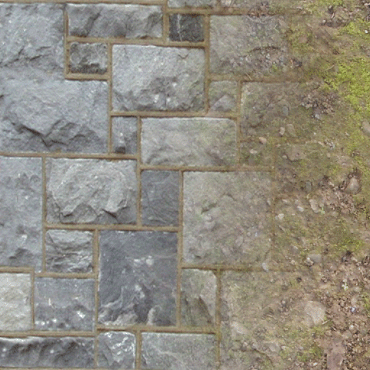
To Do Exercises
1. Recompile and run the program to see the alpha mapped texture combination. Press escape to quit.
2. Make some of your own alpha maps and use them to combine the two textures in different ways.
Source Code
Source Code and Data Files: gl4linuxtut19_src.tar.gz
![]()
![]()